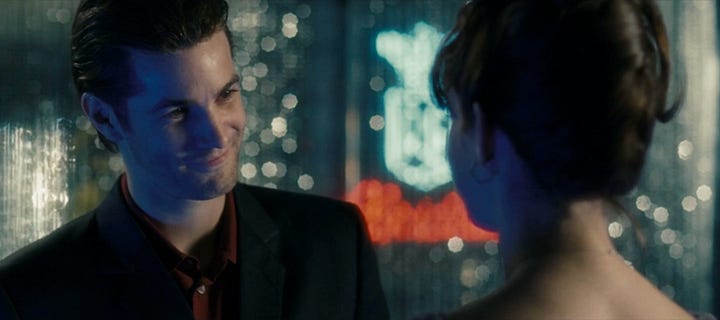Compare the Pairs: How ONE DAY Uses Shots to Contrast Relationships
One Day enjoys visual flourishes and clever scene transitions (we already talked about one — which in fact leads out of this post’s second scene!)
The transition here serves a purpose beyond inspiring ooooh aaaah; it invites us to directly compare and contrast the relationship between Emma (Anne Hathaway) and her boyfriend Ian (Rafe Spall), and Emma and ‘just friend’ Dexter (Jim Sturgess).
Relationship One
First are Ian and Emma; the scene is beige and blue, with a wide open sky reaching far into the background, and overcast weather meaning there’s not concentrated direct or high-contrast lighting.
The camera is regularly moving around them, and while they’re often in the same medium two-shot, they are rarely looking at each other, and break apart often.


The scene doesn’t repeat shot setups until the end, where Emma and Ian are framed completely seperate for the longest part of their conversation.
Transition
The scene transition could hardly be more obvious, going from a grubby ‘work in progress’ plastic sheet curtain to suave beaded curtains.
Relationship Two
Emma and Dexter are in an enclosed restaurant with higher contrast lighting and saturated colours.
After their initial medium two shot, the camera goes between them, but Emma and Dexter are always in each others’ shots (eg ‘dirty’ or ‘over the shoulder), and always looking at or at least facing each other . . .
until Dexter leaves to take his call, though because of the lighting they’re still essentially the only two things we see in the frame.


Emma herself also looks a bit different, losing the glasses especially reminiscent of a certain The Princess Diaries ‘glow-up’ as though glasses and mussy hair could actually possibly make Anne Hathaway unattractive.
Takeaways
The scenes are shot differently to invite comparison; it’s not so different as ‘bright neons and flat pastels’ or ‘fish-eye lenses versus long lenses,’ but almost every element is tweaked somewhat.
Still, many movie scenes look and feel differently to each other, and both these scenes are quite short, so how can one direct to make sure the audience does compare and contrast? The transition blatantly tying the scenes together invites us to connect the two directly.









